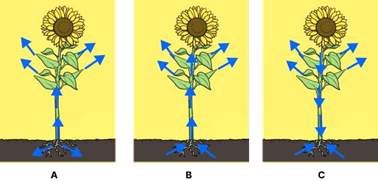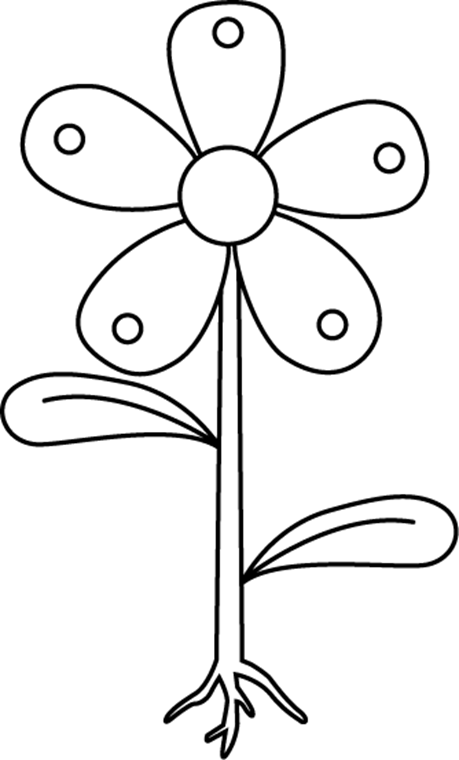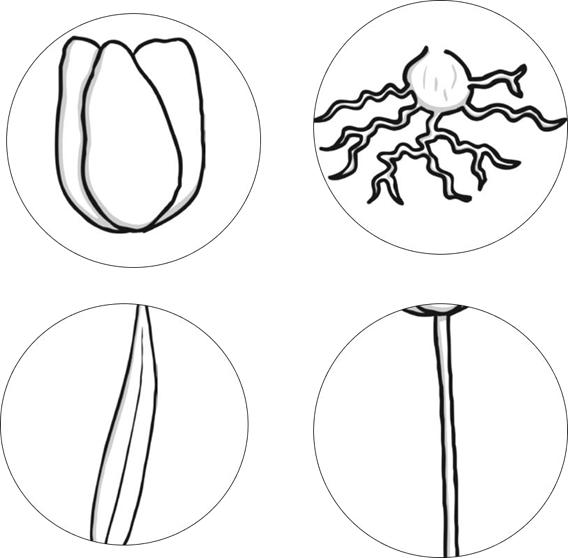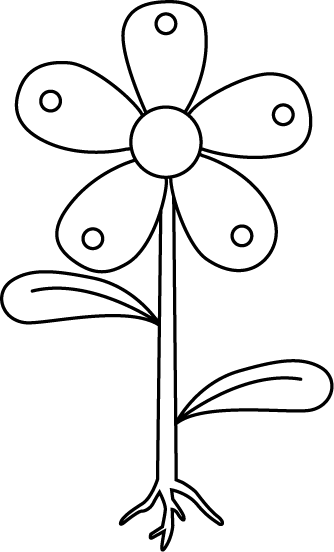Lesson plan: Parts of Flowering Plants. Water Transportation. Creating a Lapbook
Grade:5
Lesson Length:90 mins
Topic:CLIL Parts of Flowering Plants and Water Transportation. Creating a Lapbook.
Aims:
• to name and identify different parts of flowering plants;
• to describe and explain the jobs that different parts of a plant do;
• to explain how water is transported in a plant;
• to set up a comparative investigation;
• to describe the flower changes;
• to present the investigation results.
Outcomes
By the end of the lesson Ls will be able to:
• name the parts of flowering plants;
• describe the job for each part of a plant;
• record their observations;
• gather the information and arrange it in a lapbook.
Materials
3 white roses 3 glasses water
3 food colourings cardboard
|
Stage/Aim/Time |
Procedure |
Interaction |
|
Lead-in To introduce the topic 5 mins |
What do you usually give to your mum, grandma or sister on their birthday? What kind of flowers do you know? What colours are the flowers? Can we find blue or green flowers? |
Individual |
|
|
How can we turn white flowers to red, orange, green or blue? |
|
|
Reading for gist To understand the general idea of the text mins 5 mins |
Ls read the text quickly and match the headings with the paragraphs. (Resource 1)
|
Individual Whole class
|
|
Reading for specific information (parts of a flowering plant) To identify the parts of a flowering plant 3 mins |
Ls read paragraph A, underline the main parts of a flowering plant and write in their sheets. (Resource 1) |
Individual Group work |
|
Task-based activity 1 To name different parts of a flowering plant 5 mins |
Ls work in groups and fill in the first page of the investigation form. They label the parts of a plant, then they compare their completed sheets to the real flower. (Resource 2) |
Group work Whole class |
|
Reading for specific information (job description) To understand the functions that different parts of a plant do 3 mins |
Ls read paragraph B and find the information about the job descriptions the parts of a flowering plant do. (Resource 1) |
Group work
|
|
Task-based activity 2 To explain the jobs each part of a flowering plant does 5 mins |
Ls cut the parts of a plant and stick them in their investigation form. They complete the description of jobs. They look at the flower and then discuss functions of each part using their answers. (Resource 2) |
Group work Whole class |
|
Reading for specific information (water transportation) To gain the information about water transportation 3 mins |
Ls read paragraph C and answer the questions. They choose the diagram that might explain the water transportation. (Resource 1) |
Individual Whole class |
|
Experiment To make their prediction how water will be |
Step 1 Ls answer the questions to make their prediction. |
Group work |
|
transported to a flower, set up the beginning of the investigation, observe and record the results 10 mins |
Step 2 Ls set up the experiment putting a flower into the glass of water, adding 1015 drops of food colourings and record what they see. Step 3 Ls complete the form based on their investigation. (Resource 2) |
|
|
Task-based activity 1 To describe the flower changes 5 mins |
Ls observe the flower and answer the questions about its changes. (Resource 3) |
Group work |
|
Task-based activity 2 To understand and explain how water is transported in a plant 5 mins |
Ls put in the correct order the sentences on how water goes through the flower and demonstrate drawing the arrows on it. Then they check their guesses from the previous lesson. (Resource 4) |
Group work Whole class |
|
Making conclusion To summarise the information Ls have learned during the investigation 3 mins |
Ls use the information based on their investigation and describe the final product. (Resource 5) |
Group work
|
|
Pre-task To introduce the task to the Ls 4 mins |
T introduces the lapbook to the Ls and explain that they’re going to create it. T demonstrates all necessary materials. There are 4 topics: Parts of the plant, Jobs the parts of the plant do, Water Transport, Experiment (including the flower before and after). Each topic is on the one paper side. They need to use the information from the investigation folder. |
Group work
|
|
Task To arrange the information in a lapbook 15 mins |
Ls create a laptop from the group. |
Group work
|
|
Planning 3 mins |
T sticks one topic from the lapbook on the сhair back of a L. Ls prepare what |
Individual
|
|
|
they will present to the whole class. (Resource 6) |
|
|
Presentation To present the results from the group 5 mins |
Ls present their results one by one. |
Individual Group work |
|
Reflection and feedback on the lesson 5 mins To evaluate learners’ learning, reflect and give feedback |
Ls fill in a self-reflection form. (Resource 7) |
Individual |
Resource 1
A _________________________________
Plants are living things, just like you are. They’re everywhere. You can find them in some homes, in parks, in gardens and in the countryside. Plants have three important parts: the roots, the stem and the leaves. Some plants also have flowers.
B _________________________________
The roots keep the plant in the ground and hold it up. They also take in water from the soil. Leaves catch sunlight to help the plant to make its own food. The plant uses this food to help it grow. Flowers attract insects and birds. The stem holds the plant up and carries water to the leaves.
C _________________________________
All plants, even those living in deserts, need water to survive. Plants use water to keep their roots, stems, leaves, and flowers healthy. Plants absorb water from the soil. The water moves through the roots and travels up the stem. The water goes from the stem to the leaves.
1. Read the text and match headings (1-3) with paragraphs (A-C).
1. Water transportation.
2. Parts of a plant.
3. Jobs the parts of a plant do. 2. Underline the parts of a plant in the text and write them down.
1. 3. 2. 4.
3. Read paragraph C and answer the questions.
1. What do plants need to survive? Why?
2. Where do plants absorb their water from?
3. Which parts of the plants do you think are helping the plant taking up the water? 4. Choose the correct picture of water transportation.

Resource 2
Flower and Water Transportation Investigation
Group # ____________
Participants:
Parts of a flower

Description of jobs the parts of a flower do

Water Transportation Investigation
Prediction
Which picture of water transportation will be the best to explain this process? Why?
|
|
Do flowers need roots to carry water to the stem?
________________________________________________________
Method
The beginning of the investigation
Time of starting the investigation: ____________
1. What colour are the flowers ? What parts do they have ? ________________________________________________________ ________________________________________________________
2. Take a glass and fill it with 1/2 cup of water.
3. Pick the food colouring.
4. Did the water change the colour? What colour is the water? ________________________________________________________
5. Put the flower into the glass and watch to see how water come through the flower.
6. Did the flower change the colour?
Yes, it did/No, it didn’t.
7. Did the leaves change the colour?
Yes, they did/No, they didn’t.
8. Will the flower change the colour till the end of the lesson?
Yes, it will. No, it won’t.
Observation stage Fill in the gaps.
We took a glass filled with 1/2 cup of water. We picked _______ (colour) food colouring. We added about 10-15 drops of food coloring to our water. The water changed/didn’t change the colour. We put _________ (colour) flower with/without roots into the glass and watched to see how water come through the flower. After ______ minutes, the flower changed/didn’t change the colour.
Resource 3
Method
Day 2
1. What colour are the flowers ? What parts do they have ? ________________________________________________________ What parts do they have ?
________________________________________________________
2. Is the colour dark or light? ________________________________________________________
3. What colour is the water?
________________________________________________________
4. What colour are the leaves?
________________________________________________________
5. What colour is the stem outside?
________________________________________________________
6. What colour is the stem inside?
________________________________________________________
7. Do flowers need roots to drink water ?
________________________________________________________ 8. Does stem transport water to leaves and flowers?
________________________________________________________
Resource 4
Water Transport Investigation
1. Put the sentences in the correct order.
a. Then it goes up the stem. _______
b. Plants absorb water from the soil. 1
c. The water goes from the stem to the leaves and flowers. _______
d. The water moves through the roots. _________
2. Draw the arrows ↑ to show how water transports through the flower.

Resource 5
Presentation Stage
Fill in the gaps and present.
We took a glass filled with 1/2 cup of water. We picked _______ (colour) food colouring. The water changed/didn’t change the colour. We put _________ (colour) flower without roots into the glass. After 10 minutes, the flower changed/didn’t change the colour. In two days, we noticed that the flower changed the colour. The petals are light/dark ________(colour) and the leaves are ____________. So, stem tansports the coloured water to leaves and flowers.
Resource 6
|
Parts of a flower Presentation Stage Fill in the gaps and present. All plants have three important parts: ___________, ____________ and _____________. Some plants also have __________ which have many petals.
|
Jobs Presentation Stage
Choose the correct option and present.
The leaves/roots keep the plant in the ground and they also take in water from the soil. Leaves/Flowers catch sunlight to help the plant to make its own food. The flowers/stem attract insects and birds. The stem/roots holds the plant up and carries water to the leaves.
|
Water Transportation Presentation Stage Choose the correct option and present. Plants use water to keep their roots, stems, leaves, and flowers healthy. It goes from roots to stem/stem to roots then up to leaves and flowers/flowers and leaves. When you put the flower in the water with/without roots, stem transports the water to the flower.
|
Presentation Stage
Fill in the gaps and present.
We took a glass filled with 1/2 cup of water. We picked _______ (colour) food colouring. The water changed/didn’t change the colour. We put _________ (colour) flower without roots into the glass. After 10 minutes, the flower changed/didn’t change the colour. In two days, we noticed that the flower changed the colour. The petals are light/dark ________(colour) and the leaves are ____________. So, stem tansports the coloured water to leaves and flowers.
Resource 7
Self -evaluation and feedback form
|
|
Yes |
No |
|
|
1. |
Can you name parts of a flowering plant? |
|
|
|
2. |
Can you describe the jobs the different parts of a plant do? |
|
|
|
3. |
Can you record what you see? |
|
|
|
4. |
Can you explain how water goes through a flower? |
|
|
|
5. |
Can you use what you know to create a lapbook? |
|
|
|
6. |
Can you compare flowers before and after experiment? |
|
|
|
7. |
What words have you learned after today’s lesson? |
|
|
|
8. |
Did you enjoy the lesson? |
|
|
|
9. |
What is your overall impression fron the lesson? Put the number from 1 to 5. |
|
|

про публікацію авторської розробки
Додати розробку
